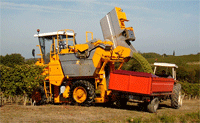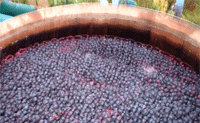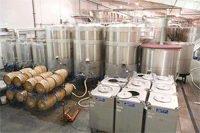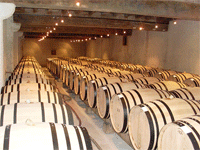Winemaking is not only an art, but also a science. It combines the process of fermentation with the creativity of the winemaker. The fermentation process starts when yeast is added to grape juice. The yeast consumes the grape's sugar and converts it to alcohol and carbon dioxide.
Winemaking, or vinification, is the production of wine, starting with selection of the grapes or other produce and ending with bottling the finished wine. Although most wine is made from grapes, it may also be made from other fruit or non-toxic plant material. Mead is a wine that is made with honey being the primary ingredient after water.
Each grape variety has its own identifiable characteristics. However, it is the winemaker who creates the style and personality of the finished wines. There is no fixed "recipe" for making certain wines, only general guidelines.

Harvest
Harvest time is the defining moment in the winemaking process. Grapes are harvested during the cool morning hours and moved to the winery in open bins.
Harvest is the picking of the grapes and in many ways the first step in wine production. Grapes are either harvested mechanically or by hand. The decision to harvest grapes is typically made by the winemaker and informed by the level of sugar (called °Brix), acid (TA or Titratable Acidity as expressed by tartaric acid equivalents) and pH of the grapes. Other considerations include phenological ripeness, berry flavor, tannin development (seed colour and taste). Overall disposition of the grapevine and weather forecasts are taken into account.
Mechanical harvesters are large tractors that straddle grapevine trellises and, using firm plastic or rubber rods, strike the fruiting zone of the grapevine to dislodge the grapes from the rachis. Mechanical harvesters have the advantage of being able to cover a large area of vineyard land in a relatively short period of time, and with a minimum investment of manpower per harvested ton. A disadvantage of mechanical harvesting is the indiscriminate inclusion of foreign non-grape material in the product, especially leaf stems and leaves, but also, depending on the trellis system and grapevine canopy management, may include moldy grapes,canes, metal debris, rocks and even small animals and bird nests.
Manual harvesting is the hand-picking of grape clusters from the grapevines. In the United States, grapes are traditionally picked into 30 pound boxes, and in many cases these boxes are consolidated into ½ ton bins or two-ton bins for transport to the winery. Manual harvesting has the advantage of using knowledgeable labor to not only pick the ripe clusters but also to leave behind the clusters that are not ripe or contain bunch rot or other defects. This can be an effective first line of defense to prevent inferior quality fruit from contaminating a lot or tank of wine.

Destemming and Crusher
Grapes are transferred to a stemmer/crusher where the stems are removed and the grapes are crushed. Some grapes may bypass the stemmer/crusher and go directly to the press for whole berry pressing.
Destemming is the process of separating stems from the grapes. Depending on the winemaking procedure, this process may be undertaken before crushing with the purpose of lowering the development of tannins and vegetal flavors in the resulting wine.
Crushing is the process of gently squeezing the berries and breaking the skins to start to liberate the contents of the berries. Desteming is the process of removing the grapes from the rachis (the stem which holds the grapes). In traditional and smaller-scale wine making, the harvested grapes are sometimes crushed by trampling them barefoot or by the use of inexpensive small scale crushers. These can also destem at the same time. However, in larger wineries, a mechanical crusher/destemmer is used. The decision about desteming is different for red and white wine making. Generally when making white wine the fruit is only crushed, the stems are then placed in the press with the berries. The presence of stems in the mix facilitates pressing by allowing juice to flow past flattened skins.

Fermentation
After crushing and de-stemming, the juice from the grapes is put into the fermentation vats, where alcoholic fermentation takes place (the conversion of sugar into alcohol and CO2). During the fermentation and aging process, which takes three(3) to six(6) months, the fermentation continues very slowly. The wine is kept under an airlock to protect the wine from oxidation. Proteins from the grape are broken down and the remaining yeast cells and other fine particles from the grapes are allowed to settle. Potassium bitartrate will also precipitate, a process which can be enhanced by cold stabilization to prevent the appearance of (harmless) tartrate crystals after bottling. The result of these processes is that the originally cloudy wine becomes clear. The wine can be racked during this process to remove the lees.
The secondary fermentation usually takes place in either large stainless steel vessels with a volume of several cubic meters of wine, or oak barrels, depending on the goals of the winemakers. Unoaked wine is fermented in a barrel made of stainless steel or other material having no influence in the final taste of the wine. Depending on the desired taste, it could be fermented mainly in stainless steel to be briefly put in oak, or have the complete fermentation done in stainless steel. Oak could be added as chips used with a non-wooden barrel instead of a fully wooden barrel. This process is mainly used in cheaper wine.

Ageing
After fermentation, the wine is transferred or "racked" into a different vessel. In some instances, the wine is aged in stainless steel tanks. In other instances, the wine is put into oak barrels where it will continue its development until bottling. After barrel ageing and prior to bottling, the wines are fined and filtered to help stabilize and clarify them.
Bottling
This is the last stage before the slow and relatively lengthy ageing process. Wines are bottled in a sterile environment, and sealed with a cork.
Different batches of wine can be mixed before bottling in order to achieve the desired taste. The winemaker can correct perceived inadequacies by mixing wines from different grapes and batches that were produced under different conditions. These adjustments can be as simple as adjusting acid or tannin levels, to as complex as blending different varieties or vintages to achieve a consistent taste.
A final dose of sulfite is added to help preserve the wine and prevent unwanted fermentation in the bottle. The wine bottles then are traditionally sealed with a cork, although alternative wine closures such as synthetic corks and screwcaps, which are less subject to cork taint, are becoming increasingly popular.